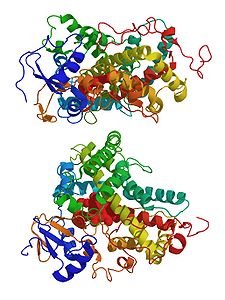Steroid 21 hydroxylase
| Steroid 21 hydroxylase | ||
|---|---|---|

|
||
| 3D structure with heme (red) according to PDB 2GEG (theor.) | ||
| Properties of human protein | ||
| Mass / length primary structure | 494 amino acids; 55.9 kDa | |
| Cofactor | Heme thiolate | |
| Identifier | ||
| Gene names | CYP21A2 ; CPS1; CA21H; CAH1; CYP21; CYP21B; MGC150536; MGC150537; P450c21B | |
| External IDs |
|
|
| Enzyme classification | ||
| EC, category | 1.14.99.10 , oxidoreductase | |
| Response type | Hydroxylation | |
| Substrate | Steroid + AH 2 + O 2 | |
| Products | 21-hydroxysteroid + A + H 2 O | |
| Occurrence | ||
| Parent taxon | Jaws | |
| Orthologue | ||
| human | mouse | |
| Entrez | 1589 | 13079 |
| Ensemble | ENSG00000168482 | ENSMUSG00000024365 |
| UniProt | P08686 | A0JP50 |
| Refseq (mRNA) | NM_000500 | NM_009995 |
| Refseq (protein) | NP_000491 | NP_034125 |
| Gene locus | Chr c6_COX: 32.1 - 32.1 Mb | Chr 17: 34.41 - 34.41 Mb |
| PubMed search | 1589 |
13079
|
Steroid-21- hydroxylase ( CYP21 ) is an enzyme that is involved in the biosynthesis of the steroid hormones aldosterone and cortisol . It catalyzes an oxidation of the carbon atom in steroids , which is necessary for the formation of these hormones.
21-hydroxylase is produced by the gene CYP21A2 . A defect within this gene causes a disruption in the formation of the enzyme, which leads to adrenogenital syndrome type 3 ( classic 21-OHD CAH ).
The reason for the frequent mutations of the gene lies in the recombination with an inactive pseudogene with which it lies on a chromosome.
Catalyzed reactions
Pregnenolone is converted to 21-hydroxypregnenolone.
17 α -hydroxypregnenolone becomes 17 α , 21-oxidized Dihydroxypregnenolon.
17 α -Hydroxyprogesterone is converted to 11-Deoxycortisol.
11 β- Hydroxyprogesterone is hydroxylated, corticosterone is formed.
Web links
Individual evidence
- ^ G. Löffler, PE Petrides, PC Heinrich: Biochemie & Pathobiochemie. 9th edition, Springer, Heidelberg 2014, ISBN 978-3-642-17971-6 , p. 501.







